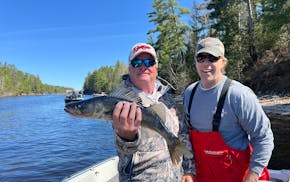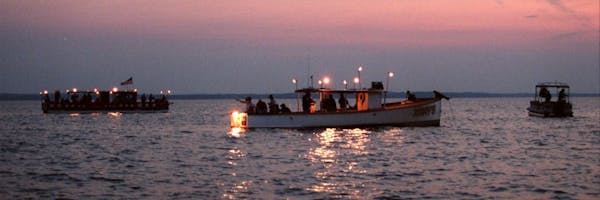Years ago when I edited a weekly paper in Ely, the time was about now, with Easter approaching, that winter's deep snow started melting. Cold had settled in early the previous fall and the border lakes' thick ice wouldn't pull away from shorelines for a few more weeks. But the angle of the morning sun had broadened, and the sense was — and you could see it on people's faces — that spring was on its way.
While in Ely, I had become friends with Sig Olson, and one day while we chatted over coffee and munched on chocolate chip cookies that his wife, Elizabeth, had baked, I told him I wanted to publish in the Ely Miner an excerpt from his book, "Sigurd F. Olson's Wilderness Days," which contains essays arranged by seasons.
The days were getting warmer, I told Sig, which I knew less by my thermometer than by the five birch logs I burned at night to stay warm in the small cabin where I lived on Garden Lake, outside of Ely. "Not too long ago I needed eight logs," I said. Also, snow on the lake was softening and neither the deer nor wolves that crossed it during the cold months dared get caught out there now. This left ravens and their haunting barks the frozen waterway's only regular visitors — those and a few whiskey jacks. These, I told Sig, were the kinds of seasonal signals he described in "Wilderness Days."
"All life is stirring now in lakes, and ponds, and streams," Sig wrote, "and in myriad tiny pools of snow water. The earth is awake at last after the long winter's sleep, and within it is a quickening. After half a year of frozen silence, spring is a miracle of rebirth, a time or rare transcendent beauty and promise."
I was recalling this the other day while thinking about the nonwinter we've had this year. I was thinking too about the blessings of living in Ely not so long ago, when the noise that accompanied day-to-day existence was dialed down quite a few notches. Perhaps being up north abetted this sense of relative quietude. But even city slickers a few decades back commuted to work without the jibber-jabber of world events tagging along so excruciatingly in their heads — the wars in Ukraine and Gaza being just two present-day examples.
Yet for those who can tune out, if even only for a brief time, mankind's fallibilities and tune in instead to the natural world, especially during seasonal transitions, life can be bathed in a kinder, gentler hue.
Scott Rall is a believer.
On a 60-degree day last week, not far from his home in Worthington, in southwest Minnesota, he was cleaning out wood duck boxes while hoping to keep mergansers from squatting in the dozen or so fake tree cavities he was placing along Little Rock Creek.
Exalting in the early spring, Scott had witnessed in recent days a seasonal trifecta: overflights of Arctic-bound tundra swans, harems of terracotta-colored hen pheasants, and the almost total forgoing this winter of yarding-up by whitetail deer. "They didn't have to yard up," he said. "They could find food anywhere and were dispersed almost the entire winter."
Not too much farther north, at Lac qui Parle Wildlife Management Area (WMA), where La qui Parle Lake was ice-free last week, migration's drumbeat grew louder still. Dark geese had arrived by the thousands, said Department of Natural Resources WMA manager Walt Gessler, and were hanging around, finding plenty of food, before pushing the snow line north. Rooster pheasants were also crowing, and the daily spiraling down on area wetlands of chromatically plumed drake mallards added a welcome splash of color to a countryside shaded tawny by winter's short days.
Farther north still, not far from Grand Rapids, Dallas Hudson noticed another natural phenomena this nonwinter. "Buck whitetails dropped their antlers later than I've ever seen," he said. "They didn't need as much energy to survive the mild winter, I guess, so they hung on to the antlers a while longer."
Living not too far away, near Brainerd, Bill Marchel said some lakes in his area are ice-free. He reported as well that while cleaning out wood duck boxes last week he was surprised to find a screech owl in one. These cute little fellows will nest in wood duck boxes from time to time, Bill noted, but finding them as far north as Brainerd is uncommon.
"Perhaps it's a sign of the mild winter," he said, adding that the landscape in his part of the state, as it is throughout Minnesota, is "scary dry."
Meanwhile, at my old haunt at Garden Lake near Ely, deer and wolves were spotted last week, bears will soon awaken, and recent temperatures in the 40s signaled spring's "rare transcendent beauty and promise," as Sig Olson wrote years ago.
Observing, and perhaps most importantly appreciating, such seasonal comings and goings can be a welcome antidote to life's more humdrum, and even tragic, events.
"It makes no difference," Sig wrote in "Wilderness Days," "if the ice is still thick on the lakes and the drifts are as deep as ever. When that something is in the wind the entire situation is changed."

Anderson: In early June, Minnesota fish are begging to be caught. Won't you help?

Anderson: Tails wagging, DNR officers' dogs find lost people and missing evidence
Anderson: Punish poachers more
Anderson: The Chainsaw Sisters Saloon is gone, but the Echo Trail is still a pathway to possibilities


